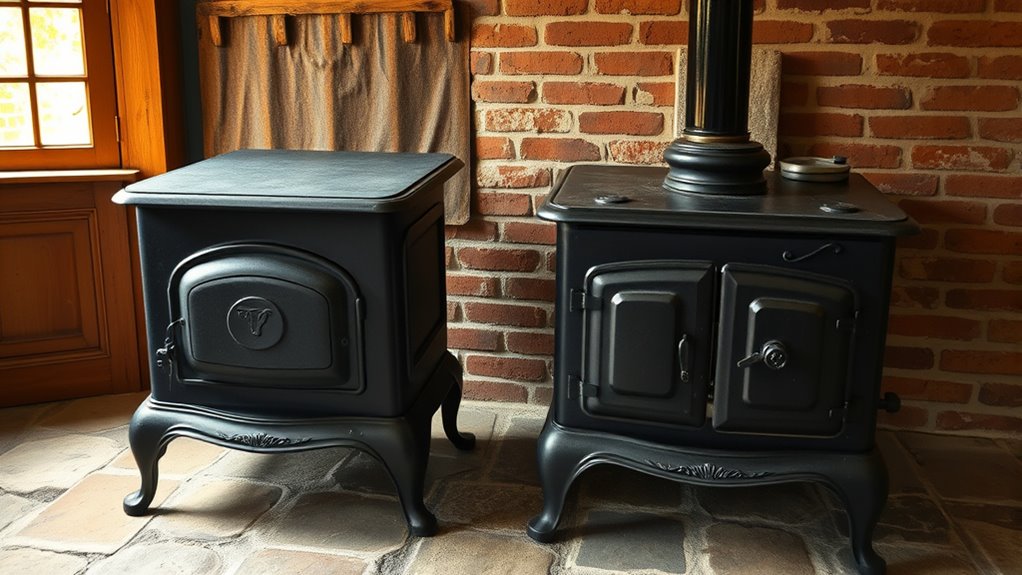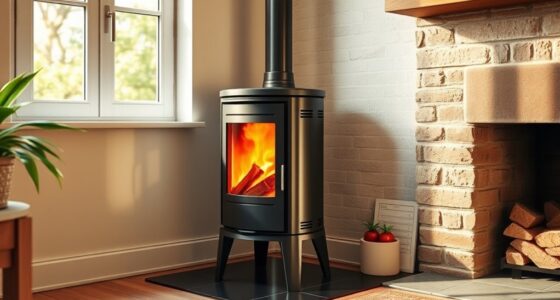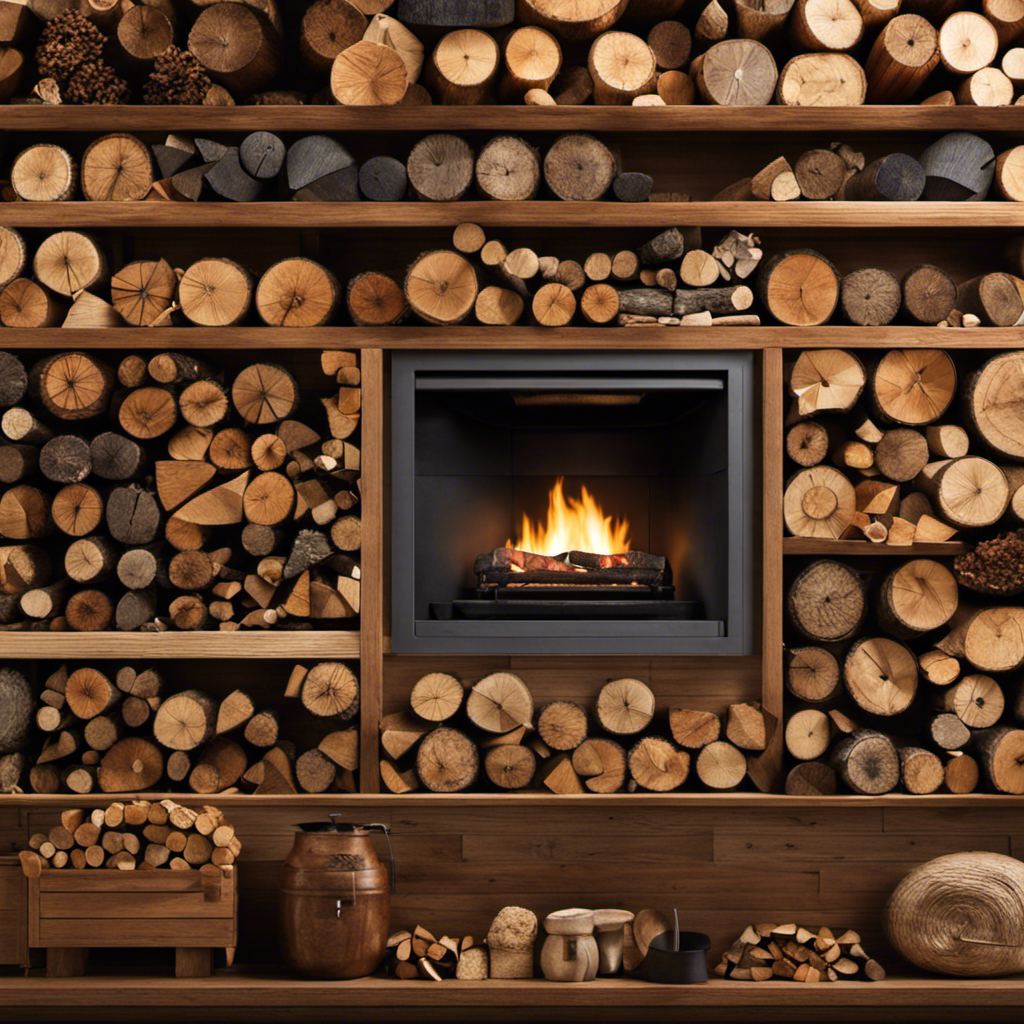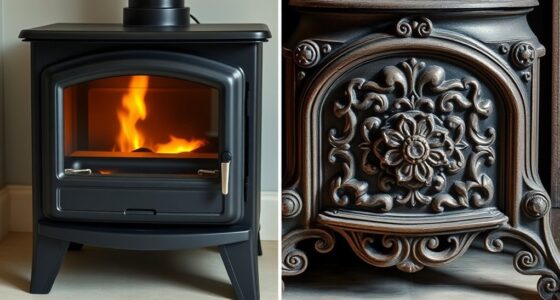If you need a stove that cooks and heats your space, a wood cookstove is your best choice, offering built-in ovens, multiple burners, and rustic charm. However, if your main goal is space heating without cooking features, a heating-only stove provides simple, efficient warmth. Consider your lifestyle, budget, and space. To discover which option suits your needs perfectly, explore the details that follow for a clear comparison.
Key Takeaways
- Choose a wood cookstove if you need both cooking capabilities and heating; opt for a heating-only stove if solely heating is required.
- Consider space and installation requirements; cookstoves are larger with integrated ovens, while heating-only stoves are simpler and more compact.
- Evaluate your fuel budget and maintenance willingness; cooking stoves typically consume more wood and need regular cleaning.
- For environmental concerns, select EPA-certified models to reduce emissions, especially for frequent use.
- Match stove capacity to your space size and heating needs for optimal efficiency and safety.
Differences in Design and Functionality
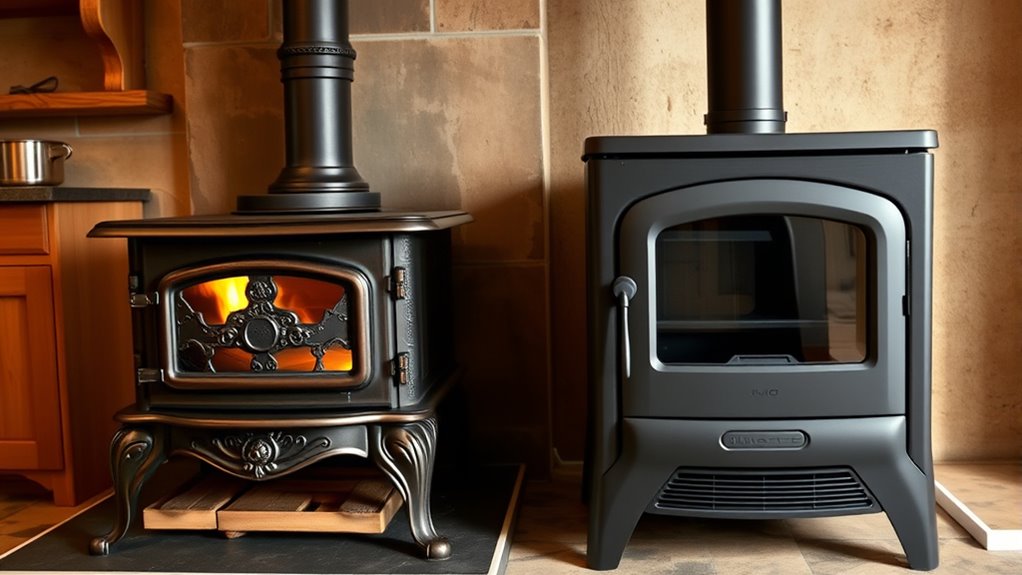
While both wood cookstoves and heating-only stoves rely on burning wood, they differ markedly in their design and functionality. Wood cookstoves often feature integrated ovens and cooking surfaces, requiring a chimney design that accommodates both heat and smoke venting efficiently. These stoves usually have better insulation needs to maintain consistent temperatures for cooking, so they’re built with thicker walls and heat-retaining materials. Proper stove installation is essential to ensure safety and optimal performance of both types of stoves. Heating-only stoves, on the other hand, prioritize maximizing heat output for space heating, with simpler designs that focus on efficient combustion and heat distribution. Their chimney design is streamlined for effective smoke removal, often with fewer features for cooking. Overall, the design choices reflect each stove’s primary purpose, influencing how they are built and installed in your home. Proper regulations and maintenance are also essential to ensure safety and optimal performance of both types of stoves.
Cooking Capabilities and Features
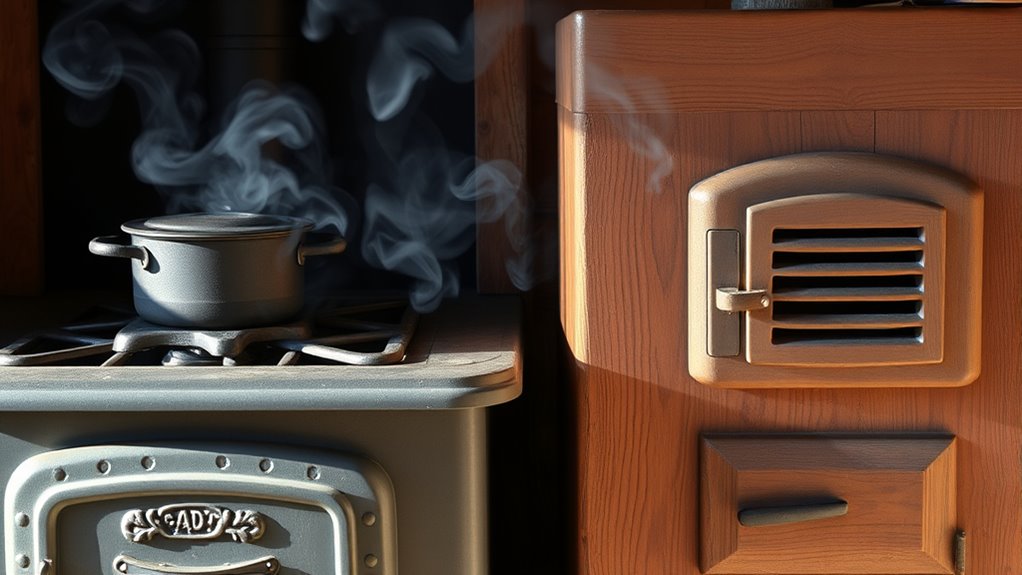
Wood cookstoves are designed to provide versatile cooking options, often featuring built-in ovens, flat surfaces, and multiple burners. These stoves excel in handling various cooking tasks, giving you control over heat levels for simmering or boiling. Many models incorporate alternative fuel sources like charcoal or even gas, enhancing flexibility. Their aesthetic design often adds rustic charm to your kitchen, blending functionality with style. Imagine preparing a stew on one burner while baking bread in the oven below. Here’s a visual of typical features:
| Feature | Description | Benefit |
|---|---|---|
| Built-in Oven | Uses heat from the firebox | Baking and roasting |
| Flat Surface | Multiple burners for cooking | Simultaneous meal prep |
| Aesthetic Design | Vintage or rustic look | Enhances kitchen ambiance |
| Alternative Fuel | Uses various fuel sources | Greater flexibility |
| Adjustable Airflow | Controls heat output | Precise cooking control |
Additionally, fuel efficiency is an important factor to consider when choosing a stove, as it impacts operating costs and environmental footprint. Modern wood cookstoves often feature innovative designs that improve energy efficiency, making them more environmentally friendly and cost-effective over time. Incorporating modern technology can further optimize performance and reduce emissions, aligning with eco-conscious preferences. Furthermore, understanding currency exchange rates can help you make more cost-effective purchases when sourcing parts or accessories internationally.
Heating Efficiency and Coverage

When comparing heating efficiency, consider how well each stove’s size and capacity match your space. You’ll want to evaluate how evenly warmth spreads throughout your home and how much fuel each stove consumes over time. Understanding these factors helps you choose a stove that offers reliable coverage without wasting resources. Additionally, considering creative problem-solving can help you optimize your heating setup for maximum efficiency and comfort, especially when integrating supplemental heating options to meet larger or variable heating needs. Proper sizing and system compatibility are crucial for ensuring your stove operates efficiently and effectively across different home layouts, and assessing fuel type can impact both performance and environmental considerations. Exploring energy efficiency measures can further enhance your heating system’s overall performance and reduce operating costs.
Heating Capacity and Size
Heating capacity and size directly impact how well a stove can warm your space. You need a stove with enough wood durability to handle your heating demands without constant refueling. Larger stoves typically offer greater heating capacity, covering bigger areas efficiently, but they also require more space and may influence your home’s aesthetic appeal. Conversely, smaller units are easier to fit into tighter spaces and can be more visually appealing, especially if you prefer a compact design. Choosing the right size ensures your home stays warm without wasting energy or sacrificing style. Additionally, heating performance metrics can help you select a stove that provides consistent and reliable warmth. Proper insulation of your home plays a crucial role in maximizing the efficiency of your heating stove, ensuring you get the most comfort with less fuel. Moreover, considering cultural narratives and style preferences can influence your choice to match your home’s aesthetic and your personal taste. Furthermore, understanding your heating needs can guide you toward the most suitable stove size and capacity for your specific space, especially when selecting a heat pump or traditional heating system that best complements your climate and lifestyle.
Distribution of Warmth
The way a stove distributes warmth considerably affects how evenly your home stays comfortable. Good heat coverage ensures no cold spots, keeping your space cozy and reducing the need for supplemental heating. Wood cookstoves often radiate heat intensely from the cooking surface and nearby areas, which can create uneven warmth if not properly positioned. An understanding of heat distribution principles can help optimize stove placement for better coverage. Proper placement also involves considering safety guidelines to prevent accidental fires from uneven heat sources or placement near flammable materials. Heating-only stoves tend to spread warmth more broadly through convection, providing more uniform coverage. When choosing, consider fire safety to prevent accidental fires from uneven heat sources or placement near flammable materials. Aesthetics preferences also matter; some stoves offer a rustic look that adds charm, while others feature sleek designs. Proper distribution of warmth not only enhances comfort but also contributes to your stove’s overall safety and visual appeal. Additionally, understanding the creative storytelling behind a brand can help you select a stove that aligns with your lifestyle and values.
Fuel Efficiency and Burn Rate
Fuel efficiency and burn rate directly impact how long your stove provides warmth and how much fuel you’ll need. Better fuel economy means you get more heat from less wood, saving you money and reducing fuel gathering time. Burn speed determines how quickly the wood burns—faster burns provide quick heat but may require more frequent refueling, while slower burns offer steady warmth over extended periods. When choosing between a wood cookstove and a heating-only stove, consider how each type manages fuel consumption and burn rate. A stove with optimized fuel efficiency balances burn speed, ensuring continuous warmth without wasting fuel. This balance is vital for maintaining consistent indoor temperatures and making the most of your wood supply. Incorporating natural techniques for efficient fuel use can further enhance overall efficiency and sustainability, leading to better air quality by reducing smoke emissions. Additionally, understanding the importance of proper stove maintenance can help prolong stove life and improve efficiency over time. Being aware of regional climate conditions can also influence the most suitable stove type for your needs, ensuring optimal performance.
Cost Considerations and Budgeting

While wood cookstoves often have higher upfront costs than simple heating-only models, understanding the full financial picture is essential for making an informed decision. Fuel cost is a key factor—cooking stoves typically use more wood, increasing expenses, while heating-only models may be more efficient. Budget planning involves considering initial purchase price, maintenance, and fuel expenses over time. Additionally, regulatory compliance can influence the costs and availability of certain stove models, so staying informed about local regulations is beneficial. Proper maintenance can also extend the lifespan of your stove and improve efficiency, potentially lowering long-term costs. Being aware of relationship dynamics and community standards can also help in assessing the social aspects associated with different stove types.
Installation and Space Requirements
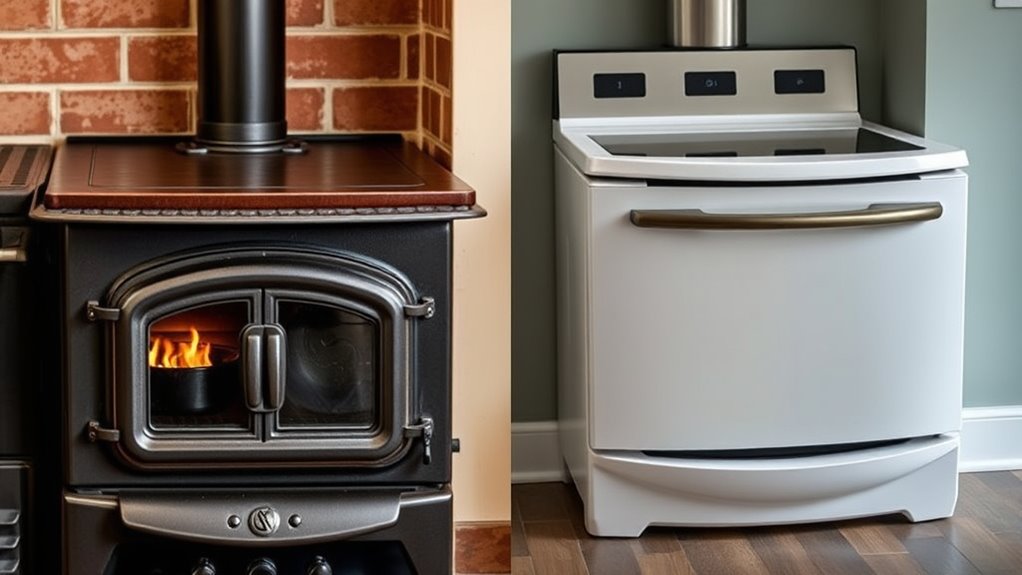
Before choosing a stove, you’ll want to take into account the space you have available to make sure it fits comfortably. Installation complexity and costs can vary depending on your home’s setup and the stove type you select. Making sure the stove’s size and installation needs align with your space can save you time and money later on.
Space Size and Fit
Choosing the right stove requires careful consideration of the space available in your home. You need to guarantee the stove fits comfortably and complements your interior. First, measure the designated area accurately to determine the maximum size you can accommodate. Second, consider the appliance aesthetics—opt for a style and color options that blend seamlessly with your decor. Third, check clearance requirements for safe operation and proper airflow. Some stoves are compact, ideal for small spaces, while others are larger, suited for open areas. Remember, a well-fitted stove enhances both functionality and visual appeal. Proper sizing prevents overcrowding and assures your stove integrates smoothly into your space, making maintenance easier and your home safer.
Installation Complexity and Costs
Installing a wood or heating-only stove involves evaluating both the complexity of setup and the associated costs. Chimney installation is a key factor; it requires proper planning to guarantee safe venting and adherence to building codes. You’ll need to determine if your home can accommodate a new chimney or if existing venting needs modification. Permit requirements vary by location and often involve inspections to meet safety standards. The process can be straightforward or complex, depending on your home’s structure and local regulations. Costs include purchasing the stove, chimney components, and potential labor. Keep in mind that permits and professional installation may increase your expenses, but they’re essential for safety and compliance. Proper planning helps avoid costly mistakes and ensures your stove operates efficiently.
Maintenance and Durability
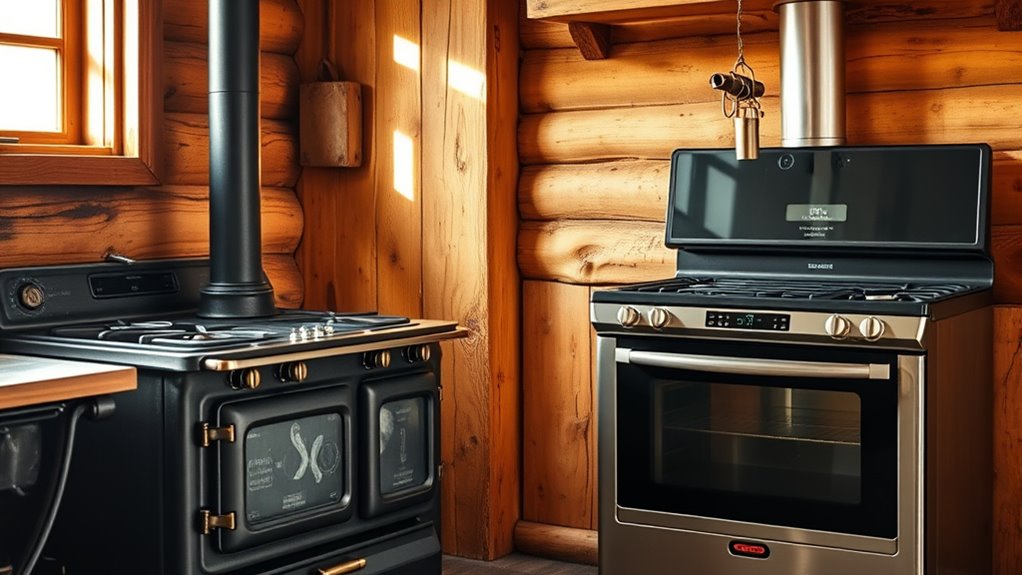
Maintenance and durability are essential factors to take into account when evaluating wood cookstoves and heating-only stoves. Your focus should be on understanding the maintenance requirements and durability factors that influence long-term performance.
- Regular cleaning of ash and soot buildup helps maintain efficiency and reduces wear.
- Material quality, such as cast iron or steel, impacts how well the stove withstands daily use.
- Proper ventilation and timely inspections can prevent corrosion and prolong lifespan.
Environmental Impact and Emissions

While wood stoves can provide an efficient heat source, their environmental impact largely depends on emissions produced during combustion. Burning wood releases pollutants like particulate matter and carbon monoxide, contributing to air quality issues. Your carbon footprint is directly affected by how efficiently your stove burns wood and whether it meets emissions standards. Choosing a modern, EPA-certified stove can markedly reduce emissions and improve combustion efficiency, leading to better emissions reduction. Proper maintenance, such as regular cleaning and using seasoned wood, also minimizes harmful emissions. Although wood stoves are renewable, poorly operated or outdated models can produce more pollution, increasing your environmental impact. To truly lessen your footprint, opt for stoves designed with emissions reduction in mind and follow best practices for burning.
Best Use Cases and Lifestyle Compatibility
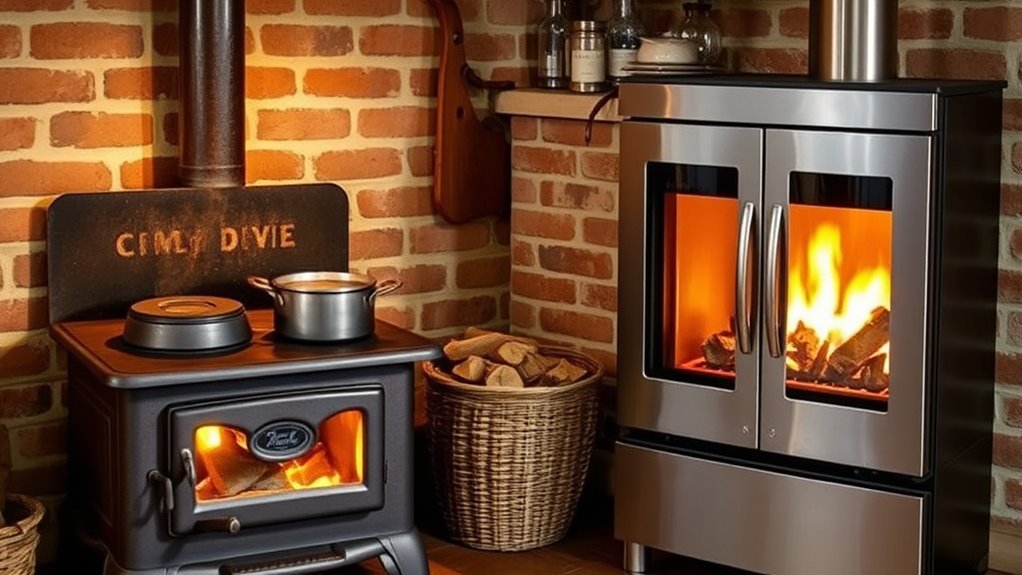
Wood stoves are best suited for households that value consistent, off-grid heating and have the space and resources to maintain them properly. They excel in scenarios requiring multifunctional appliances, combining heating and cooking in one setup. These stoves are ideal if you enjoy a rustic lifestyle or want independence from modern utilities. Consider these use cases:
- Off-grid living where reliable, renewable heat and cooking are essential
- Homes seeking energy independence and reduced reliance on electricity or gas
- Families prioritizing a traditional, cozy atmosphere with versatile functionality
While they demand regular maintenance, wood stoves offer remarkable lifestyle adaptability, blending heating and culinary needs seamlessly. If your household aligns with these priorities, a wood stove can enhance your daily routine and self-sufficiency.
Frequently Asked Questions
Can a Wood Cookstove Also Serve as a Primary Heating Source?
A wood cookstove can serve as a primary heating source, especially if it offers good space heating. While it provides cooking versatility, you should consider its size and heat output to guarantee it heats your space effectively. Keep in mind, some models excel at both cooking and heating, making them a practical choice for those wanting to combine functions, but not all are designed for primary heating needs.
What Safety Features Are Available on Modern Wood Stoves?
Did you know that modern wood stoves come equipped with advanced safety features? You’ll find fire safety measures like heat shields and automatic shut-offs that prevent overheating. Ventilation features, such as EPA-certified designs, reduce smoke and emissions, ensuring safer indoor air quality. These features help protect your home and family, making it easier to enjoy the warmth and efficiency of a wood stove without compromising safety.
Are There Government Incentives for Installing Eco-Friendly Stoves?
You might be pleased to know that government rebates and tax credits often encourage eco-friendly stove installations. These incentives aim to promote cleaner heating options and reduce emissions. By taking advantage of available programs, you can lower your upfront costs and make eco-conscious choices more affordable. Check with local or federal agencies to see if you qualify, and enjoy the benefits of a greener, more efficient heating solution for your home.
How Do Wood Stoves Affect Indoor Air Quality Over Time?
Think of your home as a delicate boat on a lake. Over time, wood stoves can introduce indoor pollution, like tiny waves that disturb your air quality. Without proper ventilation strategies, these pollutants can build up, affecting your health. Regular maintenance and good airflow help clear the air, ensuring your home remains a safe haven. Keep an eye on indoor air quality and prioritize ventilation to prevent long-term health issues.
What Are the Best Brands or Models for Durability and Efficiency?
When choosing a stove, you want a brand known for durability and models that maximize efficiency. Look for trusted names like Vermont Castings, Blaze King, or Pacific Energy, which have strong reputations for lasting quality. These brands offer models with high combustion efficiency, meaning you get more heat with less wood. Prioritize durability and efficiency to guarantee your investment pays off over time, providing reliable warmth and performance.
Conclusion
Choosing between a wood cookstove and a heating-only stove is like selecting between a versatile chef’s tool and a reliable heater. Imagine preparing a hearty meal by day, then cozying up by a warm fire at night. Each stove serves its purpose, but your lifestyle and needs determine the best fit. Whether you prioritize cooking or heating, understanding their differences helps you make a choice that keeps your home comfortable and efficient year-round.

